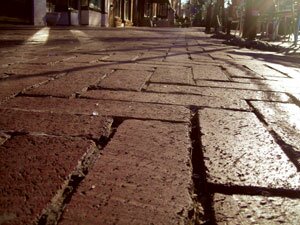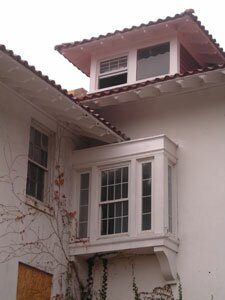ONARCHITECTURE- Building stories: Preservation, the Mall, mark '08

Brick Shtick: In 2008, we said a long good-bye to the Mall's embattled brick work after 32 years of service. Come May, we hope, the Mall's $7.5 million re-bricking job should finally make it safe for Manolo Blahniks.
FILE PHOTO BY DAVE MCNAIR
Last year, we cited the housing slump as one of 2007's big stories. It's hard to believe things could have gotten worse, but as everyone knows, they did.
Over the summer, former Federal Reserve Chairman Alan Greenspan said falling U.S. home prices were "nowhere near the bottom," and Princeton Economist Paul Krugman said that prices "probably still had a long way to fall."
Indeed, 2008 has been an exercise in painful acceptance for property owners and investors who have had to watch the value of their holdings "adjust." And there appears to be more adjusting to come.
Still, that didn't bring activity in our physical world to a complete halt in 2008, and it was actually a banner year for local preservation efforts, thanks in large part to the late-December 2007 demolition of the Beta House on Maury Avenue.
So, without further ado, here are two stand-out stories from 2008.
The Downtown Mall
After years of neglect, something chief city planner Jim Tolbert admitted to, saying, "We've not done all the maintenance we could have," the City finally approved $7.5 million to re-brick and spruce up the Downtown Mall. But not before a heated public debate about its cost, its design, and even its necessity. As downtown merchants watched the city go overtime on the Third Street re-bricking, which took nearly a year to complete though only a small fraction of the size of the Mall, some wondered if the proposed Mall project would suffer the same fate.
"I think it's a much-needed improvement," said Joan Fenton, a downtown business owner and co-chair of the Downtown Business Association, in January, "but I'm fearful, based on the city's track record, that they will end up destroying the Mall in the process."
Indeed, when early design plans for the Mall project were released, they included numerous additions, including two new fountains and a so-called Sister City Plaza on the west end.
By mid-June, City Councilors appeared frustrated with the plan, which in February they had asked to have scaled down.
Councilor Satyendra Huja characterized it as a "Christmas tree" project, with everyone adding their favorite bulb, and later called for a full accounting of the project to see where cost savings could be realized.
"Why hasn't the price tag changed?" Mayor Dave Norris inquired at a June 16 meeting, emphasizing again that Council had asked to have it scaled back.
Eventually, it was scaled back, though the budget never changed (though construction bids might have come in at a discount).
As for the design, original designer Lawrence Halprin joined local preservationists in outrage about the city's plans to use standard-sized brick pavers, and the City agreed to use 4" x 12" bricks, the elongated original that Halprin had used.
However, throughout the planning process, many wondered why the re-bricking needed to be done at all.
"It just needs to be maintained," said developer Oliver Kuttner. "There are pedestrian areas in Europe that are 200 years old. Let it become an antique old Mall. Hire a maintenance crew, some masons, and have them go up and down. It would probably cost less than $200,000 a year."
But this was something City Council never seriously considered, preferring instead to believe what city planning staff kept telling them; that the brick work on the Mall was now beyond repair.
Though many downtown merchants had originally called for the project, and later called for it to be done in the shortest time frame possible (the city hopes to have the project finished in May), as the year progressed and the economy began to suffer, anxiety began to grow.
In 2008, shops and restaurants on the Mall seemed to be dropping like flies, either closing or moving– Order from Horder, Sage Moon Gallery, Innisfree World Artisans, Les Yeux du Monde, Migration: A Gallery, Shirley Barrett's nail salon, Bohème, OXO, and Al Dente.
Event the old Mall kiosk, last used as a flower shop, was sold off in a sealed-bid auction to Keswick resident Richard Hewitt for $2,011. We recently took a look at the directory in front of the Omni hotel, and it seriously needs some updating, as many of the shops and restaurants listed are no longer with us.
Of course, some still wonder why the re-bricking is necessary. As Kuttner and others have pointed out, brick pedestrian ways have been maintained for hundreds of years in Europe, as has brick work in places like Old Town Alexandria and in historic sections of Williamsburg and Boston.
And have you ever picked up one of those old loose Mall bricks? We suggest you try it before they are gone. Long and thick and heavy, they seem too substantial to be discarded or pulverized. But they would certainly make nice door stops for the shops whose doors are still open in May.
The Beta House fall-out

The back of Beta House shows Bradbury's attention to detail and symmetry, a quality the Jefferson Scholar's Foundation deemed unworthy for preservation.
FILE PHOTO BY DAVE MCNAIR
The Beta House, also known as the Compton House, was an Italianate residence long occupied by the Beta Omega Pi fraternity. After its purchase last year by the Jefferson Scholars Foundation, the group announced– after winning the right from the City and County to issue $18 million in tax-free bonds– that it would raze the structure.
Despite public outcry, the Foundation went ahead with the demolition to make way for its new $21 million headquarters on the Maury Avenue site. Council members said they assumed the Foundation was going to preserve the building when they approved the bond issue, but they were wrong.
Some preservationists called the demolition of a structure designed by famed local architect Eugene Bradbury "disgusting" and a "vandalism" abetted by the public treasury, and the City's preservation planner, Mary Joy Scala, called the destruction "a lost opportunity to demonstrate that preservation is the cornerstone of sustainability."
The unapologetic demolition energized the preservation community and prompted Scala to present a plan to better protect historic properties at a January 7 City Council meeting at which councilors Dave Norris, Satyendra Huja, Holly Edwards, Julian Taliaferro, and David Brown all appeared to be in favor of better protecting historic properties.
"We need to act, with all due haste," Taliaferro said. And responding to the frustration over the loss of the Beta House, Brown said, "I deeply regret we didn't take a closer look."
Council then directed the Board of Architectural Review to come up with a list of key historic properties prioritized based on the threat of demolition. The BAR reviewed hundreds of such properties, compiled by Scala, and eventually selected 12 for special protection, including the Fry's Spring Service Station and the Fry's Spring Beach Club on Jefferson Park Avenue, the circa-1937 Monticello Dairy Building on Grady Avenue, and the Patterson Wing of Martha Jefferson Hospital.
In essence, the designations protected the properties from demolition or alteration by giving the BAR the same review power it would have if the property were located in a designated historic district. In the past, City Council asked property owners for their permission to make these designations, but now they appeared ready to enforce them.
Almost immediately, the new policy raised some hackles.
"The designation means that we'll have to give up our ability to control the property to a governmental entity. That bothers me," said Ed Gillaspie, president of the Fry's Springs Beach Club, a not-for-profit institution along Old Lynchburg Road that was originally built as a resort hotel in 1890.
"The owners understand the City's desire to protect the building," said Mike Morris, manager of the Monticello Dairy Building, raising the hot-button issue of property rights when discussing the possible designation, "but we're worried about the future development potential."
Finally, near the end of the year, Preservation Piedmont announced the formation of a new group, the Piedmont Area Preservation Alliance (PAPA), an umbrella group of about a dozen organizations that plans to meet twice a year to establish preservation priorities, and most notably, to notify one another of when places are endangered.
Late in 2008, both Charlottesville City Council and its Board of Architectural Review managed to save the Moon-Henderson House on 10 1/2 Street from the wrecking ball, denying owner Bill Chapman permission to demolish.
But despite the decision, and despite all these new preservation efforts, there's one thing preservationists simply can't fight: the market.
According to city code, Chapman can put the property up for sale at fair market value, and if he can't find a buyer within 12 months, he has the right to demolish it, despite the wishes of the BAR and City Council. And since Chapman has already put the Moon-Henderson House on the market, listing it for last year's City assessment of $162,600 (he bought it in 2005 for $115,ooo), the clock is already ticking.
It would have cost $300,000 to renovate the 1,400 square foot building, and because of the small lot size and required setback, there was no room to add an addition, according to Chapman, who says he understands Council's decision not to green-light a demolition.
"Why approve a demo in light of the Beta House," says Chapman, "and why make an unpopular decision when there's a process in place to let the market decide its fate?"
"Did the Beta House experience wake us up to the need to be more proactive in saving our local history from the wrecking ball?" asks mayor Norris. "Absolutely."
Norris also thinks the "process" Chapman mentions is a good one.
"If the community values a particular building enough to save it from demolition, then the community has a year to raise the funds necessary to purchase and renovate that building," he says. "In the meantime, the owner is prevented from demolishing it."
Of course, in a year of mass foreclosures, bank failures, and bailouts, some might question the wisdom of letting the market decide the fate of anything.
#